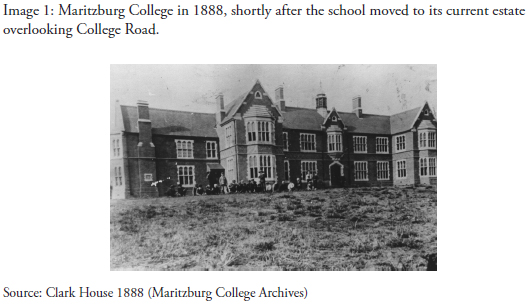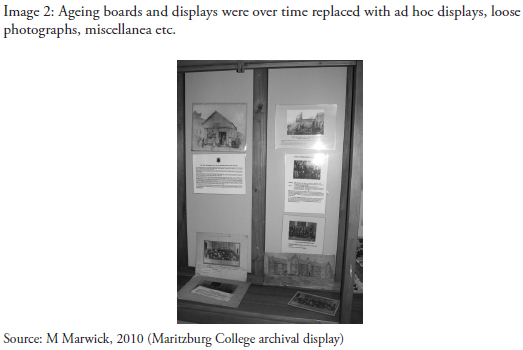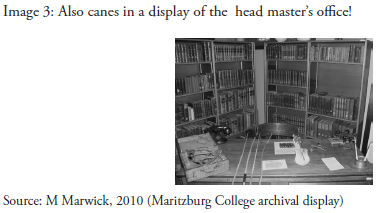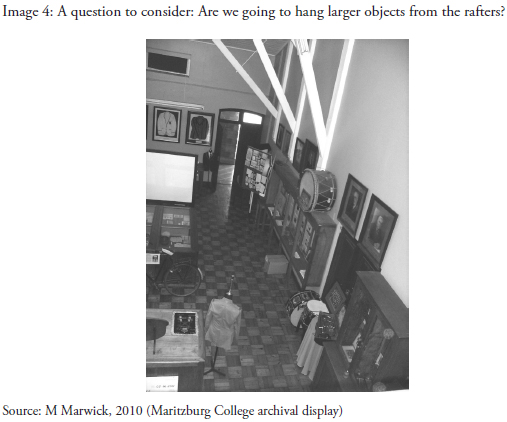Services on Demand
Article
Indicators
Related links
 Cited by Google
Cited by Google Similars in Google
Similars in Google
Share
Yesterday and Today
On-line version ISSN 2309-9003
Print version ISSN 2223-0386
Y&T n.5 Vanderbijlpark Jan. 2010
ARTICLES
Setting up a school museum
Matthew Marwick
Mr. Maritzburg College. KwaZulu Natal. marwickm@mc.pmb.school.co.za
ABSTRACT
The creation of a school museum offers an opportunity for a school and its broader community to celebrate the institution's no doubt unique history and heritage, and to offer an "open book to the world" of its history, contribution to society and its character. Whilst professional museum planners might be employed to take on the task of managing the overall project and tackling the rather daunting list of "To Do's", their services are expensive, and might cause a school's Governing Body to balk at the anticipated costs. In this article, Pietermaritzburg teacher, Matthew Marwick, summarises the journey undertaken by the members of the Museum Planning Committee at Maritzburg College, as they upgrade the school's existing museum, which currently is primarily made up of ad hoc displays of photos and memorabilia, in the build-up to the school's 150th celebrations in 2013. In the article, he points out some of the difficulties already experienced during this venture (which is ongoing), and offers practical advice to educators who might be considering a similar undertaking.
Keywords: School museum; Heritage preservation; Museum planning; Maritzburg College; School History research.
Introduction
The school at which I am employed, namely Maritzburg College, is celebrating its 150th birthday in 2013. One of the many components of what will be a busy year will be the opening of a new school museum, the planning for which commenced in 2009. I am a member of that small planning committee, as well as the school's Archives Committee, which oversees all such heritage-related matters at the school.
The purpose of this paper is not to be a deeply researched academic treatise on museum planning - far more weighty tomes dealing with this subject can be ordered on www.amazon.com - but rather a brief practical guide to school museum planning that attempts to share with fellow school heritage buffs the challenges faced by their brethren in Maritzburg. Thus, it may be regarded as an informal - because not all of the steps need to be followed, and the order can vary from school to school - and rather generic roadmap for the setting up of a school museum, from conception to delivery.

The heritage "set-up" at Maritzburg College
The first museum at Maritzburg College was set up in honour of the school's 125th celebrations in 1988 by Mr Simon Haw, with assistance from the boys of his Special History Project. But with Mr Haw's departure from the school in 1989, it was unfortunately allowed to gradually fall into disrepair, and its ageing boards and displays were over time replaced with ad hoc displays, loose photographs, miscellanea etc, which collectively do not do justice (we on the Museum Planning Committee submit) to a grand old school. Importantly, too, the school's old archives, which had flourished at the time of Mr Haw's writing of the school's definitive history in that momentous year, had at best stuttered along in the decades that followed. Very few of the old photographs and irreplaceable documents had been properly preserved or scanned into digital format, and they had, sadly, been rather brutally man-handled during their various moves over the subsequent years.
Arising from an appreciation that the school's 150th celebrations would attract the attention, support and indeed attendance of many of its 15 000 living Old Boys - who, generally, are a loyal bunch of fellows - there emerged a realisation at Maritzburg College by 2008 that a new museum needed to be set up, and that, ideally, it should be completed by the start of the celebratory year, 2013. Thus, and after some deliberation, the Maritzburg College Museum Planning Committee was duly formed at the end of 2009.
Fortunately, the school already has a long-established Archives Committee, which for more than two decades has at its quarterly meetings pondered various archives- or heritage-related issues. The chairman of the committee is the Headmaster, and the committee has for more than a year now accepted the need for a new museum. At the start of 2010, a part-time archivist was appointed on the recommendation of the committee by the school, and she has already commenced the exhausting task of recording and preserving the school's old photos and documents, and, importantly for the purposes of this address, driving the process of establishing a new school museum at Maritzburg College. She is an enthusiastic, precise retired former Director of a local municipal museum and is well-connected in the KZN Midlands museum community.
What follows in due course is a brief summary of the process followed by the Archives Committee at Maritzburg College in setting up its own Museum Planning Committee and starting the laborious process of establishing a new museum, which, it is hoped, will be formally opened on the school's 150th birthday on 2 March 2013.

Why set up a school museum?
Before we move on to the practical aspects of this address, let us first pause and consider why a school might wish to go to the invariably considerable expense and time of setting up a school museum. In this regard, I would suggest that a school museum might have any of a number of purposes, including -
• Providing simply a celebration of a school's history and heritage, which in many cases are unique, special, and much-treasured by its alumni.
• Providing an "open book to the world" not just of the history of the school, but its contribution to society and its character; in fact, its very soul.
• Providing a vital asset in the all-important, these days, marketing of the school within the broader community. In addition to the considerations already mentioned, I would argue.
The planning steps
The following is a summary (with one or two additions) of the planning steps followed since January 2010 by the Maritzburg College Museum Planning Committee. The steps have been amended slightly, so as to be of greater relevance to a school that might be starting the entire process from scratch:
Preliminary Steps
• Familiarity: As the originator of your school's museum project, you will be required to read some of the literature available on the Internet, purchase one or two books, if need be, and speak to experts in your area. You might obtain a copy of Starting Right: A Basic Guide to Museum Planning published by the American Association for State and Local History. Perhaps there is a local museum, whose curator might be able to advise you about starting up a museum, themes that you might consider, and, vitally, the costs involved? Familiarise yourself fully too with the archival material at your disposal at the school, so as to get an idea of the extent of the task before you. This will give you an idea, too, of the time and therefore expense required to complete your project.
• The overall concept/idea: What type of display or museum do you envisage? What is the broad concept or "idea" that you want to address? Is it going to deal with the entire history of the school or will it be a mere slice (like the 'History of Sport', of a boarding House or of the Headmasters/Headmistresses)?
• Obtain the initial support, in principle, and perhaps over tea in the staffroom even, of the key individuals at your school. For example, you may want to bounce a few ideas past your headmaster or your bursar, to ensure that the project - with further support - is feasible. A key initial question will no doubt be where might you house your new museum - will a building have to be built or is there existing space available? Of course, the issue of cost is a vital and potentially project-breaking one.
• Form a steering committee: Consult with experts in your area, perhaps ask them to join your committee; approach motivated people within your school community - past and present staff, alumni, people with a shared passion for the history of the school, even capable pupils (like Mr Haw did in 1987-8) - whom you think will be able to assist. However, the steering committee should not, in my view, exceed six people. Ensure that formal minutes of its meetings are taken.
Business matters
Within your committee, and over its initial first few months, you will need to deliberate on many issues, weigh up many options, and carry out a number of tasks, which will include the following:
• Draw up a mission statement for your museum. This should serve as a clearly articulated blueprint to help you plan a museum and decide what will be in the collection:
- What is the likely name of your museum?
- What is the central purpose of your museum?
- Who is your target market? Who are your potential and/or likely visitors? For example, a museum that is geared in the main towards the pupils themselves will probably require more multi-media and colourful features than one geared towards a school's grey-haired alumni.
• Carry outweb searches for the details of local museum professionals, and consult them, even if it is only initially over the telephone or via e-mail. You need to get a - at this stage - vague idea of what options are before you, what themes might appeal to you, the probable extent - and thus cost - of your particular project etc.
• Visit other museums and, especially, school museums in your area. Take note of what you like and don't like, and ask as many questions as possible of the curator and staff.
• Carry out an initial audit of your existing historical records and artefacts:1
- What artefacts do you already have?
- What artefacts can you obtain over the next few months and years?
- How are you going to obtain them? Are you going to rely on donors, and how active are you going to be in your pursuit of them?
• Start considering the future "look and feel" of your museum:
- Traditional: dark wood, low lighting, luxurious, like the Grey College museum, which oozes class and gravitas.
- Modern: chrome, glass, vibrant, well-lit.
- Ethnic: rural scenes, traditional artefacts.
- Home-grown and simple: a museum created by the school itself, using staff expertise and pupil labour, scanned photos etc. The rather low-key but nonetheless effective museum at Kearsney College, visited by our Planning Committee in May 2010, showed how successful such an approach might be.
- A combination of any of the above.
• Thereafter, brainstorm within your committee about the museum's possible displays,2 like (in our case) -
- What space do we have available for our new museum and how are we going to use it?
- Are we going to hang larger objects from the rafters?
- How can we best use our existing collection of valuable Victorian books and memorabilia (including family photographs, moth-eaten rugby jerseys and ominous-looking bent old canes) - by recreating a classroom, a hostel dormitory, the headmaster's office etc?
- How can we integrate and use our upstairs space?
- What colours do we want to use on the walls and display divisions? (Perhaps you are 'restricted', like we are, to a degree by your school's own colours?)
- Are we going to install multi-media features, like TVs, touch-screens etc.3
• Decide on the likely themes for your museum, for example (once again, in our case):
- The school's 15 Headmasters, in order;
- Academics and Culture;
- Sport;
- Alumni;
- A space for additional alternating displays? In the case of Maritzburg College, we have an annual need for displays on such diverse events and occasions as the Duzi Canoe Race (January), Founders' Day (March), Old Collegians' Reunion Day (around June), the Old Boys' Induction Ceremony (October) and Remembrance Day, and a display on, say, corporal punishment at the school would no doubt be fascinating for pupils past and present.
• Compose various written museum policies (for example, those relating to collections and donations, access to the museum, the storage and use of photographs, fund-raising etc);
• Request that professional museum planners submit their formal written proposals relating to the design, layout, construction, visitor flows, architectural requirements, display cases and exhibits, lighting and carpeting, maintenance etc of your museum project, the ultimate responsibility for which will eventually rest upon the tender winner, who will be the project manager. Your budgetary constraints will probably limit how far and wide you cast the net for possible contractors. In our case, we have contacted two local museum contractors, as well as a Pretoria-based organisation that has in the last few years set up a number of attractive school museums. We felt that we could not approach the planners of such notable museums as the Apartheid, Lilliesleaf Farm (Rivonia) and Hector Petersen Museums.
• You might also wish to consider the ancillary services offered by some museum planners, which can be wide-ranging and extend far beyond mere displays, colour-schemes and the use of multi-media, and include-
- the care of various school archives collections;
- the registration and storage of archival material;
- future exhibitions;
- the long-term conservation and future renovation of your archives;
- part-time staffing;
- financial management;
- the marketing of your museum (including signage, liaison with the local media, and the alignment of your museum with the local Provincial Museum Services);
- prospects for the future expansion of your museum; and
- fund-raising.
• Adjudicate and consider the various proposals submitted by the museum planners, and make your all-important selection.
• Draft a final budget and, if necessary, business plan for your museum project: You will now need to determine the anticipated total costs of your museum project, so that you can thereafter formally approach the "key individuals" already mentioned, to assess the availability within your school of financial resources for the project over the next couple of years. Costs that you will need to include in your budget are the following:
- the estimated costs already submitted by the museum planners above;
- location rent, purchase or construction;
- utilities, staff (possibly part-time), and insurance; and
- advertising, licenses and memberships.
You will then also have a better idea of the money that the museum will in the future need to generate, considering school and/or government funding, private donations and possible ticket income. In this regard, perhaps you have a wealthy alumnus who has an historical leaning and might be prepared to assist his/her old school? Perhaps you will have to gather together the costs of the project from school fees over the next few years?4 Perhaps you have a Past Scholars' Association that might also help?5 A new museum may cost anywhere from R1 000, for a rather simple collection of photographs, to R500 000 and more.
• Your final task will then be to convince your headmaster/headmistress, Chairman of the school's Governing Body and bursar that the setting up of a school museum is a much-needed project that should most certainly proceed.
• Thereafter, and only after that formidable hurdle has been overcome, can the project manager be appointed and finally commence his/her work! (In our particular example, this is to only take place in early 2011, once the gruelling collation task of the archivist - see below - has progressed somewhat.)
• Given that the work of the project manager is heavily dependent on the archival material available, one of your first tasks will be to collate and organise your archival material. The size and thus likely cost of this task will depend on factors like the size and age of your school, whether you have an existing collection and/or archivist, the ability and efficiency of the school to call for additional historical artefacts, documents etc. For example, how organised and up-to-date is the database maintained by your Past Pupils' Organisation? Ideally, your school will have over some years already begun collecting matters of historical interest, which can then provide the core of your museum's future displays. Of course, a call could then immediately be made to the entire school community - incorporating present and past pupils, staff, parents etc - for the submission of anecdotes, memorabilia, miscellanea etc.
• Thus, one of your early tasks may be to hire paid assistants, from a perhaps part-time archivist6 to the professional museum planners themselves.
Conclusion
As is apparent from the above, the setting up of a school museum is a time-consuming, often rather laborious process, which might earn its originator the allegation that he/she is wasting the precious resources of the school. However, in our experience at Maritzburg College there exists a lasting appreciation in many quarters of the school's broader community for the benefits of having a professionally-set up school museum, of which everyone upon its completion can be proud. After all, it is often a school's character and heritage that set it apart from its competitors, and are unifying sources of pride for its pupils, staff, parents and alumni.
1 A professional archivist may be vital for this job.
2 Although you will rely on the views of the professionals whom you will eventually contract to do the job, you still nevertheless should formulate some idea of what you and your school community might want. For example, a survey of staff, past pupils etc at a traditional all-boys' school might reveal that a club-like atmosphere is an appropriate 'look and feel' for a school museum. This would need to be conveyed to planners, who do at times like to be rather revolutionary in their designs.
3 But beware - these do tend to cause the costs of a museum project to balloon!
4 It is likely that Maritzburg College will in this manner fund the majority of the costs of its museum project.
5 The Secretary of our Old Boys' Association is a very keen supporter of the museum project, and simply added an "Old Boys' Museum Appeal" to the annual subscriptions' invoice. This, and other alumni-related appeals, has in the last 18 months brought in about R150 000 of unexpected contributions.
6 In the case of Maritzburg College, this was of immediate importance, given the extent of the school's rather jumbled archives.
















